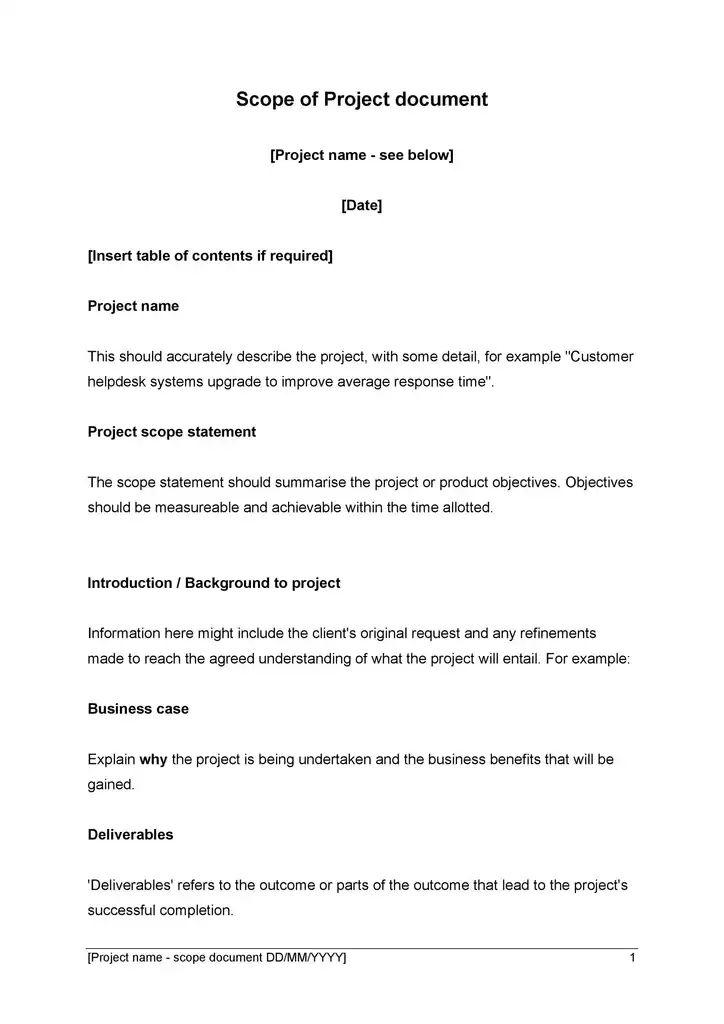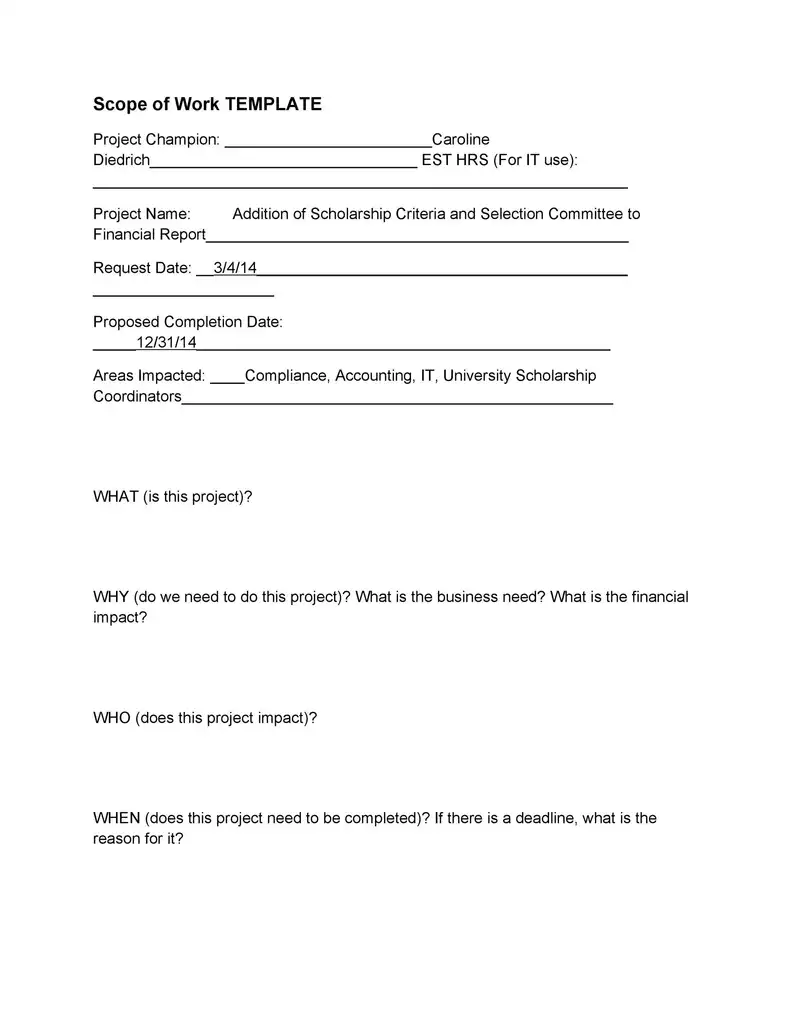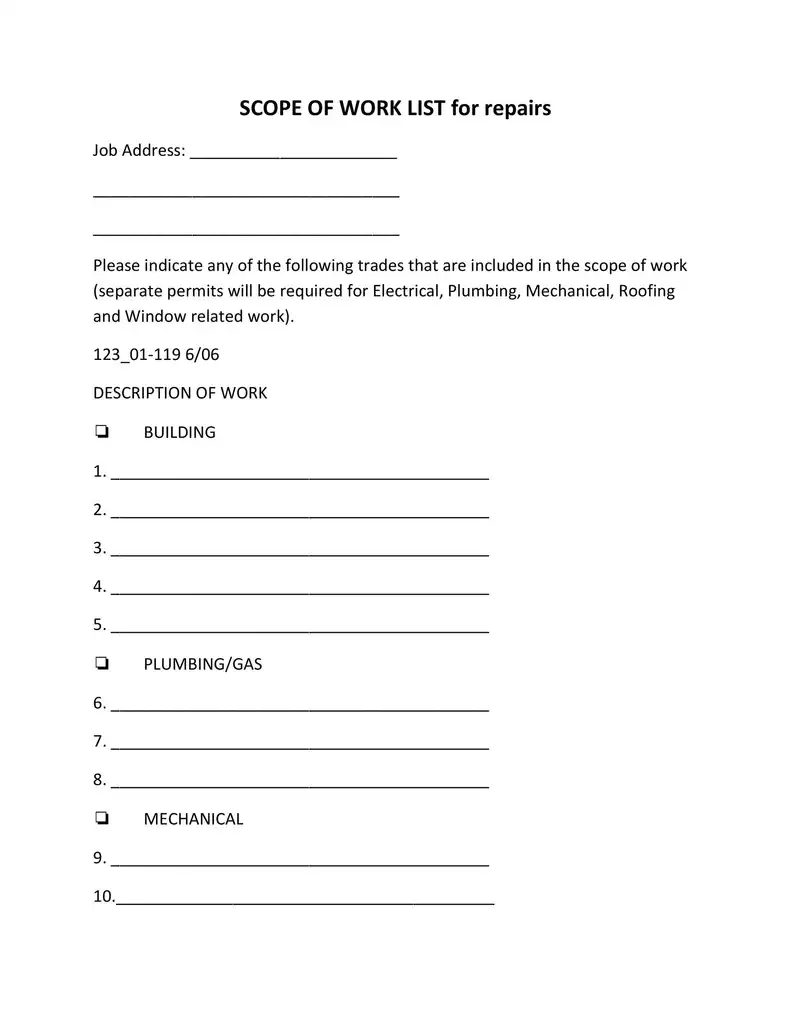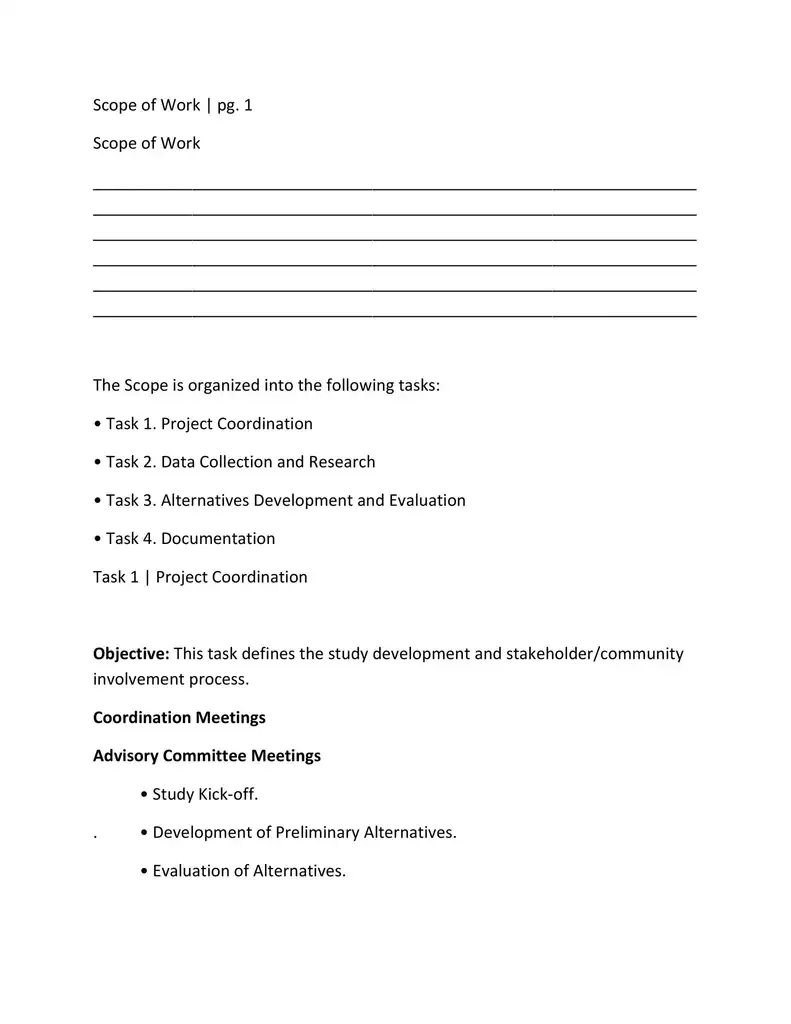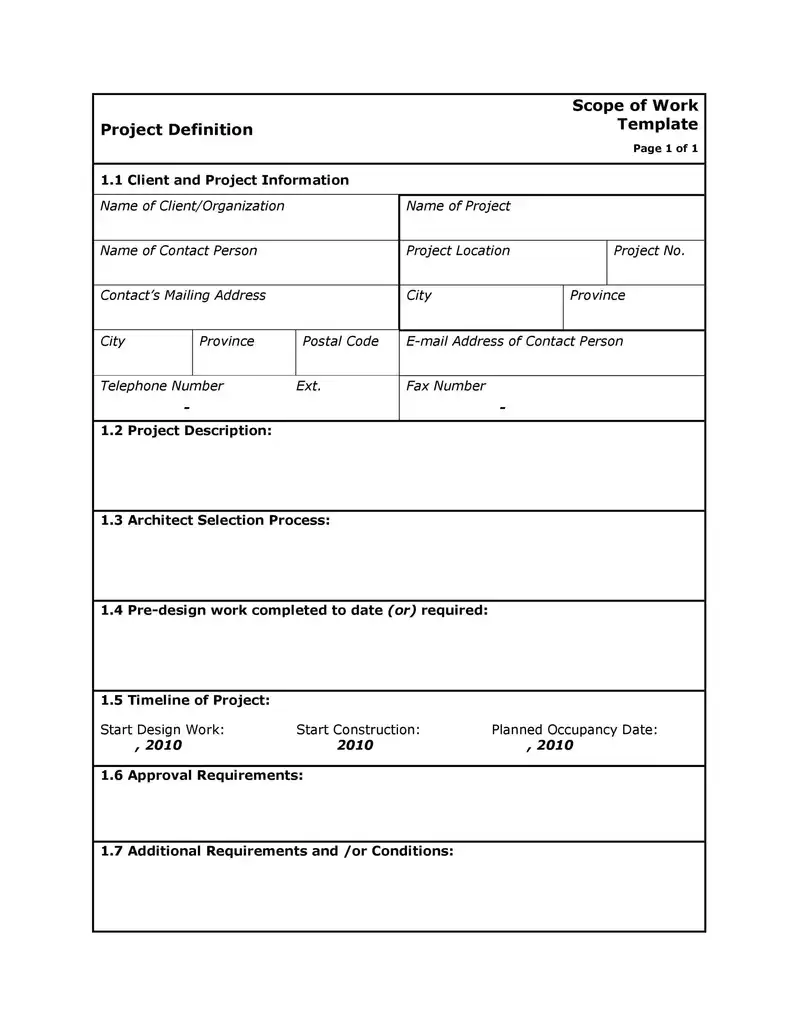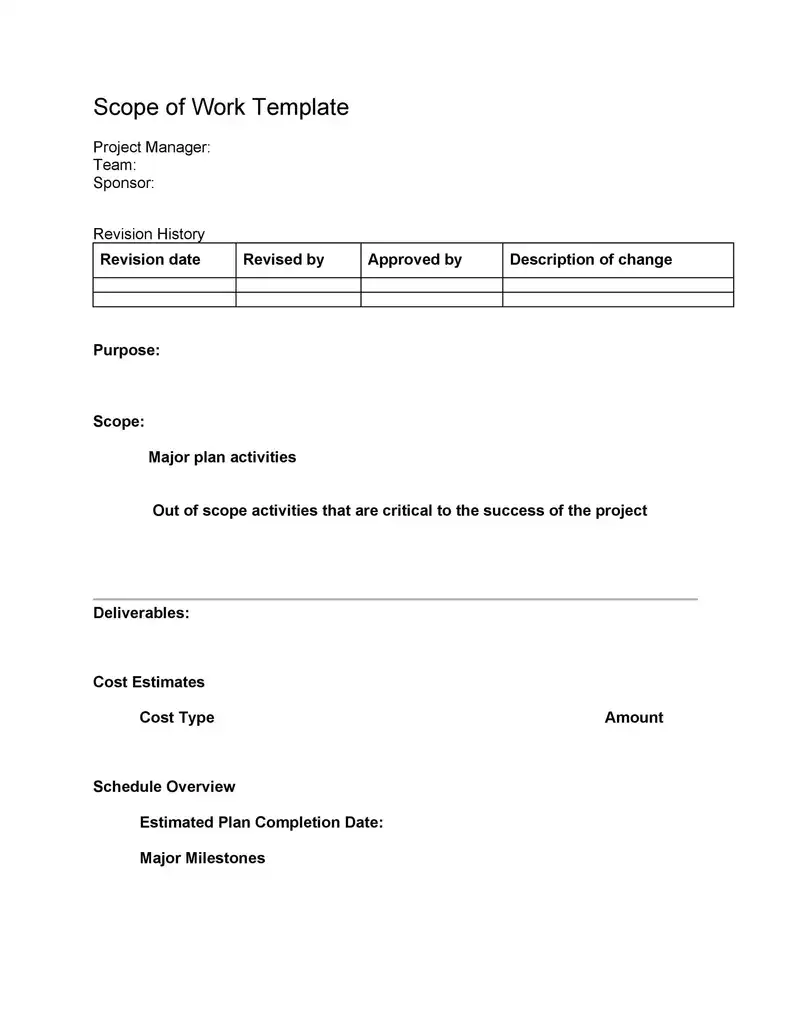Are you looking for the free scope of work templates? You are currently on the right page because here, we will give you not only the brief and easy-to-understand explanation but also the examples of Scope of Work template that you can freely download from this page.
What does Scope of Work mean?
Scope of Work, which is often called Statement of Work is the work activities, deliverables – the things that must be given or executed to the customer, including goods or services – and the timelines from the vendor, which a company or a party should do in an implementation of the work desired by the customer. It can include detailed requirements, prices, as well as the agreed terms and conditions.
A Scope of Work is usually written in an official contract. It can be legally equivalent to a work contract. The only difference is that a contract usually explains the obligations and rights of each party – both vendor and customer, while the scope of work usually only explains obligations that must be delivered by the relevant vendor.
Tips for Writing a Scope of Work
Writing can be challenging, especially for those new to project management. However, with the right approach, you can create an SoW that is clear, comprehensive, and effective. Here are some advice to help:
- Be Specific and Detailed: The more precise and detailed, the better. Clearly define the duties to be completed, the deliverables to be produced, and the timeline for completion. Avoid vague or ambiguous language that could lead to misunderstandings.
- Use Clear, Simple Language: While your SoW should be detailed, it should also be effortless to comprehend. If you must use technical terms, be sure to define them.
- Define Responsibilities: Clearly define the responsibilities of each party interested in the task. It has the responsibilities of the service provider or contractor and the client or project initiator. By clearly defining each party’s responsibilities, you can ensure accountability and control disputes.
- Include a Timeline: Include a timeline for the project, outlining when it will start, when it will end, and when key milestones or deliverables are due. It helps keep the project on track and allows all parties to plan their activities accordingly.
- State What is Included and Excluded: Clearly state what is included and excluded from the project’s scope. It helps prevent scope creep and ensures all parties comprehend the task.
- Review and Revise: Once you’ve written your SoW, take the time to review and revise it. Check for any missing information or unclear descriptions. Make sure the SoW is clear, straightforward, and effortless to comprehend.
- Get Feedback: Before finalizing your SoW, get feedback from all parties involved. It can help assure everyone is on the exact page and that the SoW meets everyone’s needs.
By following these tips, you can complete a Scope of Work, comprehensive and practical. It can help set your project up for success and ensure a smooth and productive working relationship with all parties involved.
Characteristics of a Good Scope of Work
It is an essential document in task management, serving as a roadmap that guides the project from start to finish. However, not all SoWs are created equal. Clear descriptions, comprehensive details, and early definitions characterize a good SoW. Let’s explore these characteristics in more detail.
Clear Descriptions of What is Included and Excluded
One of the critical characteristics is the clarity of its explanations. It should clearly explain what is contained in the task’s area, detailing the tasks to be performed, the deliverables to be created, and the timeline for completion. It helps establish clear anticipations for all groups involved and guarantees everyone is on the same page regarding the task.
Just as essential as stating what is included in the area and what is excluded. It helps prevent scope creep, which occurs when additional tasks or deliverables not initially agreed upon are added to the project. By clearly explaining what is not included in the task’s area, the SoW helps protect all parties from unexpected work and keeps the project focused on its original objectives.
Obligations of Both Parties
A good SoW also clearly outlines the obligations of both parties. It has the responsibilities of the service provider or contractor, such as the jobs they are expected to perform and the standards they are expected to meet. It also includes the responsibilities of the client or project initiator, such as providing necessary information or resources and making timely payments.
Clearly defining each party’s obligations, the SoW helps ensure accountability and promotes a fair and balanced working relationship. It also provides a basis for resolution in case of disputes or non-compliance.
Project Tenure
The SoW should clearly state the project’s tenure, including the beginning and end dates and any essential milestones or deadlines. It helps guarantee that all groups clearly comprehend the job’s timeline and can plan their activities accordingly. It also provides a basis for tracking the project’s progress and assessing its performance.
Defining the SoW at the Beginning of a Project
Finally, a good SoW is defined at the beginning of a project. It is crucial for setting clear expectations, preventing misunderstandings, and protecting each party’s interests. By defining the SoW early on, all parties can agree on the project’s scope, deliverables, timeline, and responsibilities before work begins. It can save time and resources, prevent disputes, and ensure smooth project execution.
Clear descriptions, comprehensive details, and early definitions characterize an excellent Scope of Work. Ensuring your SoW has these characteristics allows you to set your project up for success and protect your interests throughout the task lifecycle.
Understanding the Scope of Work
It is recorded in task management. It functions as a detailed roadmap for a task, drafting the job activities, deliverables, and timelines that guide the scheme from inception to completion. Beyond its role as a task guide, an SoW also carries significant legal weight, often functioning as a binding contract between parties. Let’s delve deeper into understanding the Scope of Work.
Defining Project Parameters
At its core, an SoW clearly explains the work required for a task. It drafts the characteristic jobs, the deliverables to be produced, and the timeline for fulfilment. Here’s how an SoW defines these key project parameters:
- Work Activities: It provides a comprehensive list of tasks or activities to be performed during the project. It includes everything from preliminary research and planning to execution and final review. By outlining these tasks, the SoW provides all details to comprehend the job applied and the actions that must finish the project.
- Deliverables: It also specifies the tangible results or deliverables of the job. These could be reports, products, software, or tangible impact from the scheme’s activities. The SoW sets clear expectations for what will be produced by the project’s end.
- Timelines: The SoW recaps the project’s timeline and contains beginning and end dates for individual tasks or deliverables. It confirms that all details are on the exact page regarding when a job should be finished and allows for adequate scheduling and resource distribution.
As a Legal Document
An SoW also serves as a legal document. Once decided upon and marked by all groups, the SoW becomes a binding agreement that outlines each party’s obligations and duties. In this sense, it is equivalent to a job contract.
If a dispute arises during the project, the SoW can be guided to resolution. It delivers a recorded record of what was approved, supporting enforcement accountability and protecting each party’s rights. In some cases, the SoW may even be used in court to prove the contract between groups.
The Examples of Scope of Work Templates
If you are still not sure about how to make a good Statement of Work, you can easily download the Scope of work templates from our website. However, they are only raw templates, which require you to adjust the contents based on your needs. By using our templates, your work will; become much easier because all you need to do is to simply fill in the framework to create a complete and systematic Scope of Work. Besides, it will also save you time because you do not have to think hard about what to write in order.
Free Scope Of Work Templates
Creating a Scope of Work (SoW) can be daunting, especially if you’re new to project management. Many websites offer downloadable Scope of Work Templates to simplify this process. These templates provide a structured format for your SoW, ensuring you include all the necessary information and maintain a professional appearance.
Scope of Work Templates are pre-formatted documents created to help you make a comprehensive and systematic SoW. They typically contain sections for all the vital parts of an SoW, such as task description, duties, deliverables, timeline, and responsibilities. Some templates may include additional sections for project assumptions, exclusions, or terms and conditions.
These Scope of Work Templates are usually available in standard document formats like Word or PDF, making them easy to download and customize. They can be used for many projects, from small, simple projects to large, complex ones.
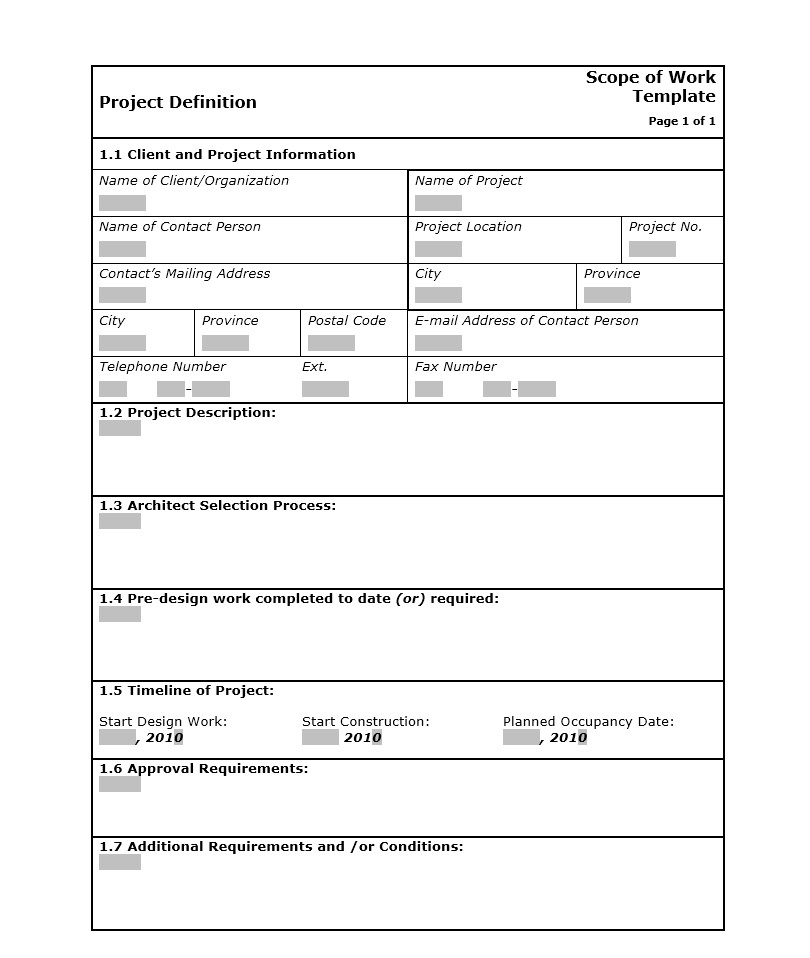
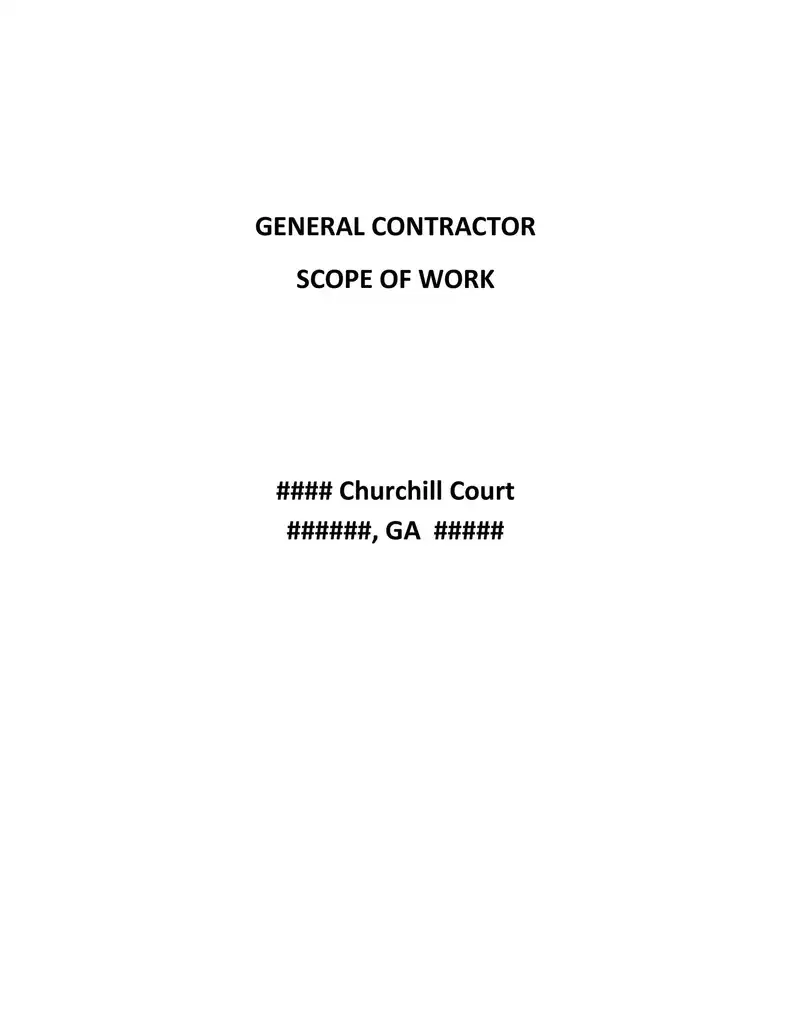
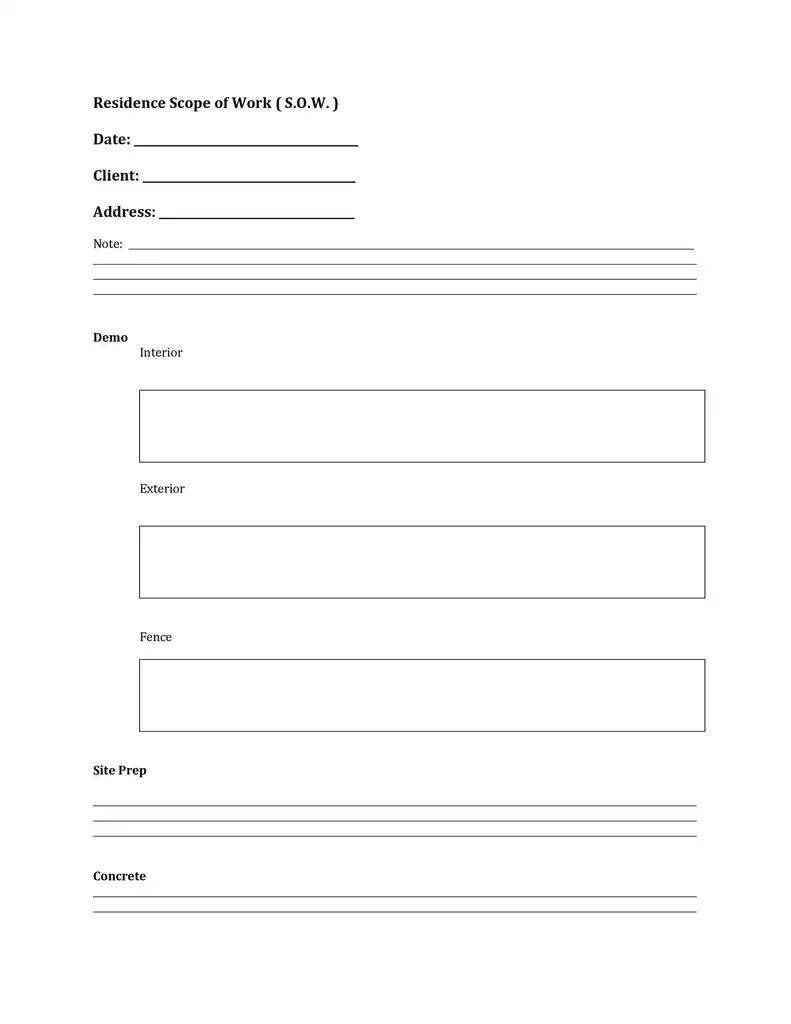
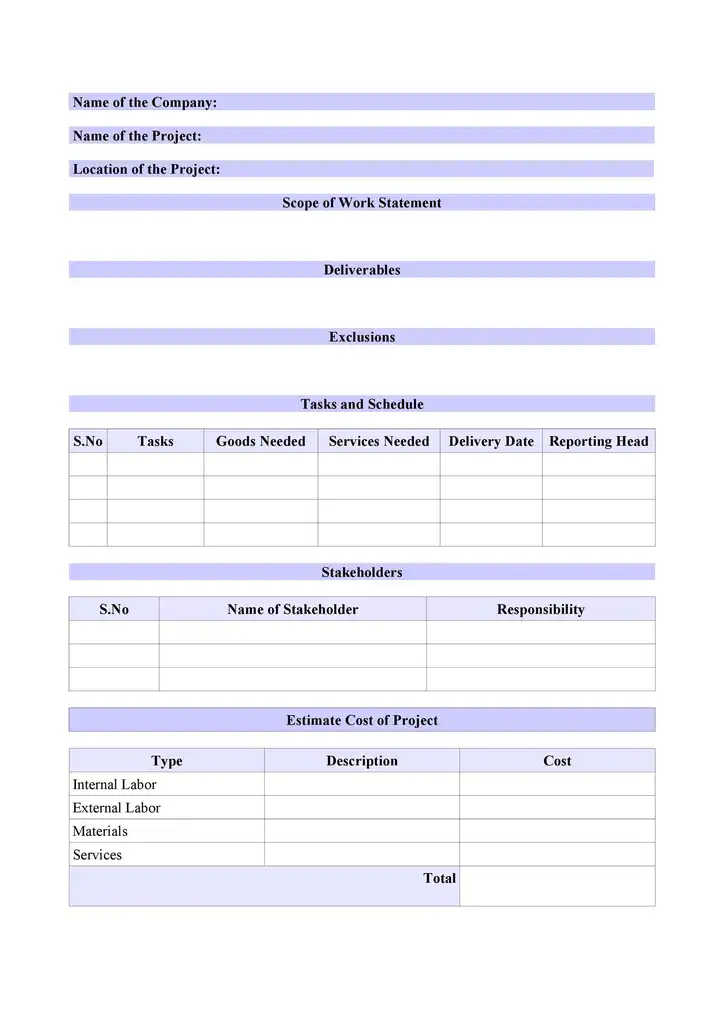
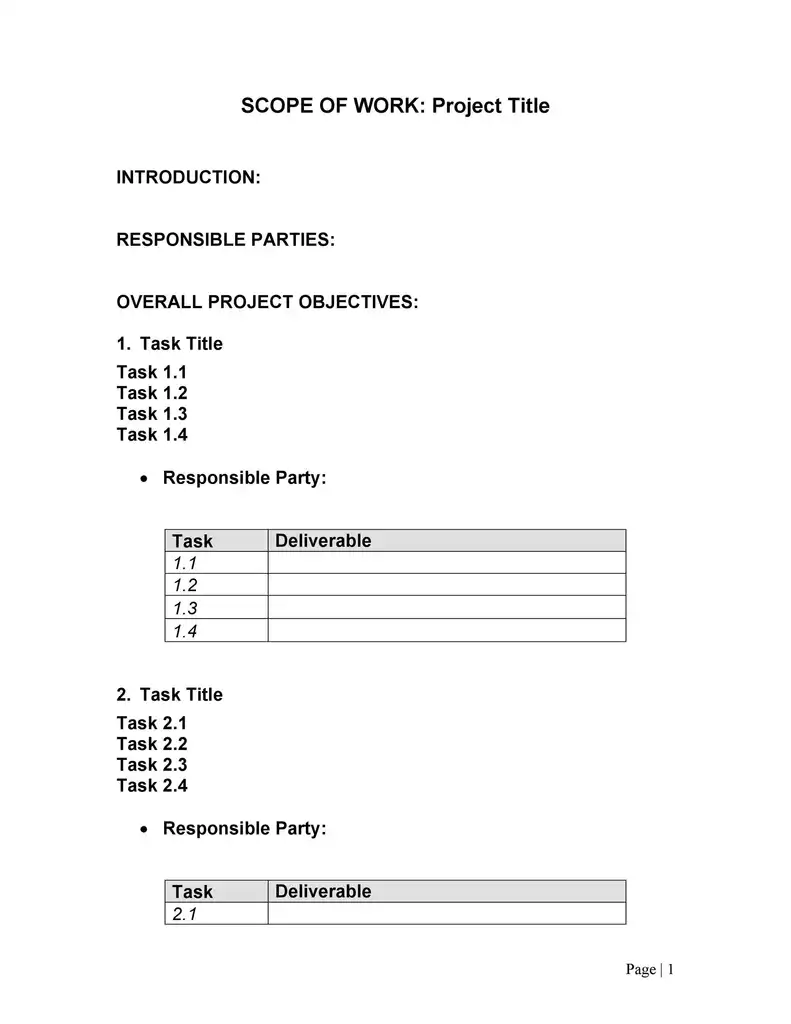
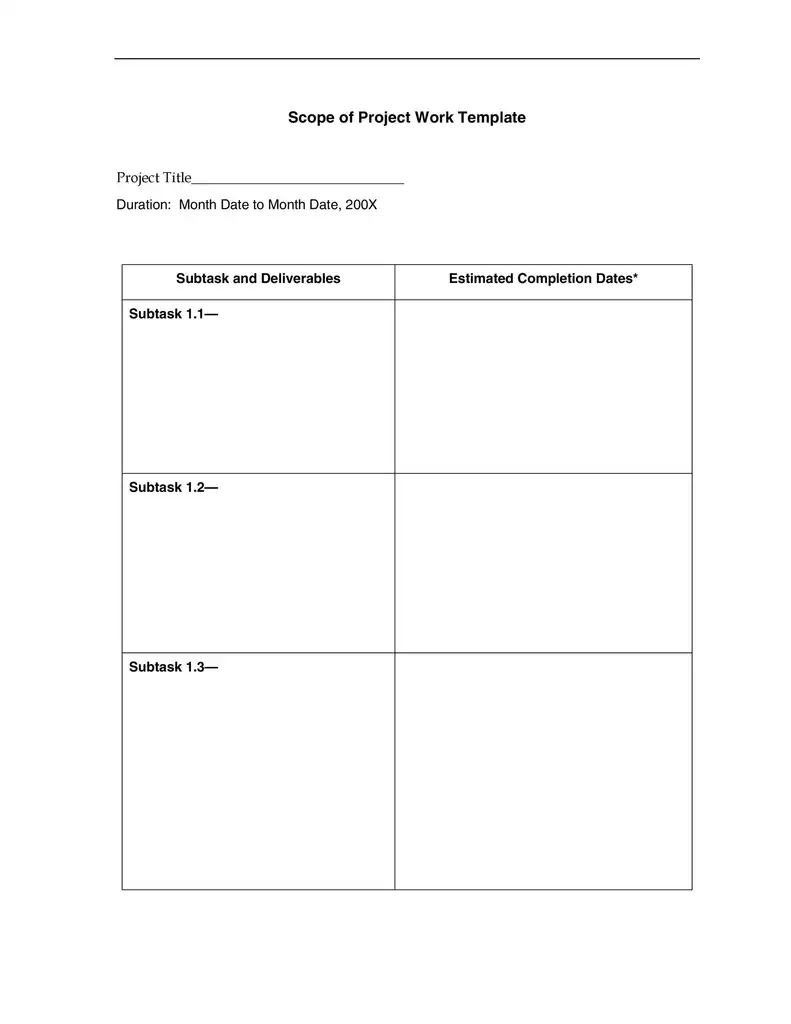
Scope of Work Template Word, PDF, Docx, and Excel
The format of your SoW template can depend on your specific needs and preferences. Word and Docx formats are great for text-heavy SoWs and allow easy editing and formatting. PDF format is ideal if you want a non-editable, professional-looking document that can be easily shared and viewed on various devices. Excel format is perfect for projects involving a lot of data, calculations, or timelines, as it allows easy data manipulation and analysis.
Scope of Work Template for Construction
In the construction industry, an SoW is essential for defining the work that needs to be done, including the construction tasks, materials needed, and safety protocols. A construction SoW template might include areas for task summary, assignment tasks, project schedule, and times and requirements.
Scope of Work Template for Software Development
Software development projects require a clear SoW to outline the software’s features, stages of development, testing procedures, and deployment process. A software development SoW template might have sections for project objectives, deliverables, technical needs, project phases, and acceptance criteria.
Scope of Work Template for Cleaning Services
For cleaning services, an SoW outlines the areas to be cleaned, the cleaning tasks, the frequency of cleaning, and any special instructions or standards. A cleaning services SoW template might include sections for services to be provided, a cleaning schedule, standards of performance, and terms of agreement.
Website and Software Scope of Work Templates
For website and software projects, an SoW defines the features to be developed, the user interface design, the testing procedures, and the deployment process. These templates might have areas for task summary, project phases, deliverables, technical needs, and assignment timelines.
Interior Design Scope of Work Template
An SoW outlines the design process in interior design projects, including the design tasks, materials and furnishings, and project timeline. An interior design SoW template might include sections for project overview, design process, deliverables, project schedule, and terms and conditions.
Scope of Work Template for Software Development
A software development SoW template outlines the software’s features, development stages, testing, and deployment. It includes sections for project objectives, deliverables, technical requirements, project phases, and acceptance criteria, ensuring a clear understanding of the software’s functionality and development process.
Scope of Work Template for House Renovation
An SoW for house renovation projects details the renovation tasks, materials, design plans, and timeline. It includes sections for project overview, renovation tasks, project schedule, and terms and conditions, ensuring the homeowner and contractor understand the renovation’s scope and expectations.
Scope of Work Template for IT Projects
An IT project SoW template outlines the objectives, technology, tasks, and timeline. It includes sections for project summary, technical requirements, project phases, deliverables, and project timeline, ensuring alignment on the project’s goals and steps.
Scope of Work Template for Website Development
A website development SoW template outlines the website’s features, design, development stages, testing, and deployment. It includes sections for project objectives, website features, design and development process, testing and deployment, and project timeline, ensuring clarity between the client and developer on the website’s functionality and development process.
Scope of Work Template for Consultants
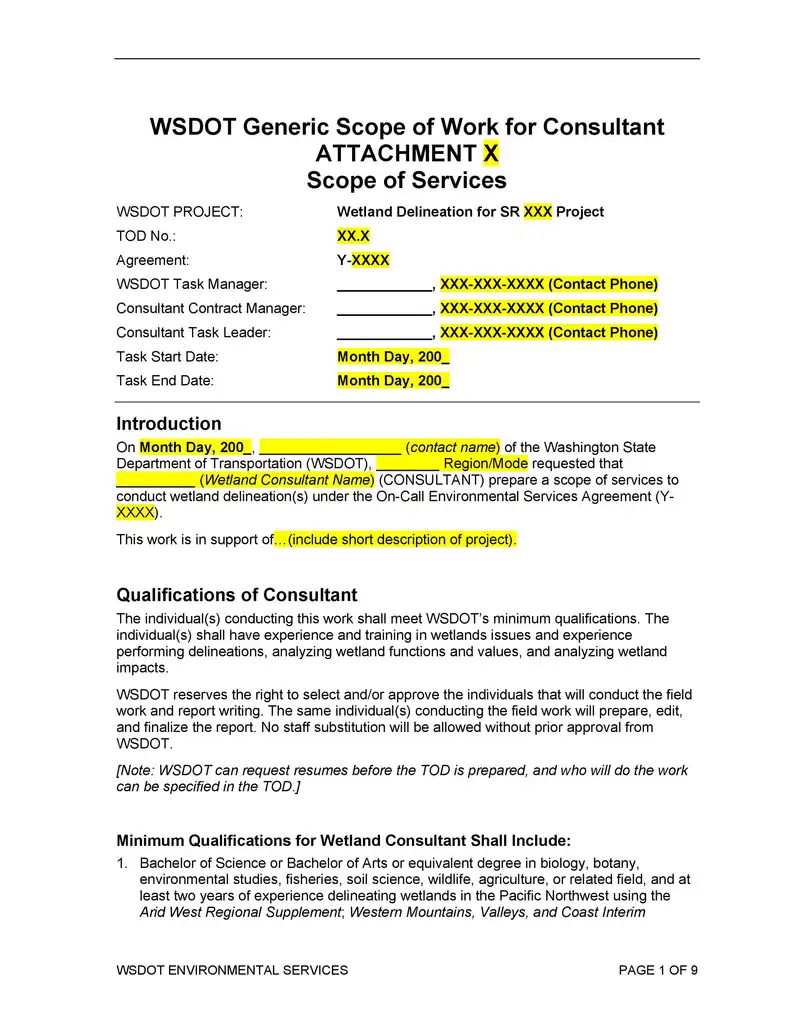
Consultants use an SoW to define their services, deliverables, and project timeline. A consultant SoW template includes sections for project overview, services to be provided, deliverables, project schedule, and agreement terms, setting clear expectations between the consultant and the client.
Scope of Work Template for Network Cabling
A network cabling SoW template outlines the cabling tasks, materials, installation process, and project timeline. It includes sections for project overview, cabling tasks, project schedule, and terms and conditions, ensuring the client and contractor understand the cabling work’s scope and expectations.
Scope of Work Template for Event Planners
Event planners use an SoW to define the event’s details, planning tasks, schedule, and special requirements. An event planner SoW template includes sections for event overview, planning tasks, event schedule, and agreement terms, setting clear expectations between the event planner and the client.
The Importance of a Scope of Work in a Project
In project management, a Scope of Work (SoW) is a critical document that outlines the specific tasks, deliverables, timelines, and resources associated with a project.
It serves as a roadmap guiding the project from start to finish, ensuring that all parties clearly understand what is expected. We will delve into the importance of an SoW in a project and how it can prevent prolonged debates and protect each party’s interests when necessary.
Preventing Prolonged Debates
One of the primary benefits of an SoW is its ability to prevent prolonged debates and misunderstandings. By clearly outlining the project’s scope, deliverables, and timelines, an SoW ensures that all parties have the same understanding of what the project entails. This clarity can prevent disputes over what was agreed upon, as everything is documented in the SoW.
For instance, if a disagreement arises about a particular task or deliverable, parties can refer back to the SoW to resolve the issue. It can save time and resources otherwise spent on lengthy discussions or debates, allowing the project to progress smoothly.
Protecting Each Party’s Interests
An SoW also plays a crucial role in protecting each party’s interests. For the project initiator, it ensures that the service provider or contractor understands and agrees to deliver what is expected. For the service provider or contractor, it provides a clear description of the work they are expected to perform, protecting them from scope creep or additional tasks not initially agreed upon.
Moreover, an SoW can serve as a legal document in case of disputes or non-compliance, protecting both parties. It can be used as evidence of what was agreed upon, helping to enforce accountability and protect each party’s rights.
When is an SoW Necessary?
While an SoW benefits most projects, it may only be necessary for some. Generally, an SoW is crucial for complex projects involving multiple tasks, deliverables, or stakeholders. It is also essential for projects with high risk or uncertainty, as it provides a clear plan and sets expectations for all parties involved.
On the other hand, for simple, straightforward projects with clear tasks and outcomes, an SoW may be optional. However, a basic SoW can still clarify and prevent potential misunderstandings, even in these cases.
a Scope of Work is a vital tool in project management. It helps prevent prolonged debates, protects each party’s interests, and provides a clear roadmap for the project. Whether you’re a project manager, a service provider, or a stakeholder, understanding the importance of an SoW can help ensure the success of your projects.
How to Use Scope of Work Templates
Using an Scope of Work Templates is straightforward. Here’s a step-by-step guide:
- Download the Template: First, download the SoW template from the website. Select the template that best fits your project’s requirements.
- Customize the Template: Open the template in your preferred document editor. Replace the placeholder text with your scheme’s data. Be sure to have all the necessary details, such as the tasks, the deliverables to be produced, and the project’s timeline.
- Review the SoW: Once you’ve filled out the template, review your SoW to ensure it’s complete and accurate. Check for any missing information or unclear descriptions. Make sure the SoW is clear, concise, and easy to understand.
- Share the SoW: After reviewing your SoW, share it with the other parties involved. It could be your client, team members, or other stakeholders. Get their feedback and make any necessary revisions.
- Finalize the SoW: Once everyone has agreed on the SoW, finalize it. It could involve getting signatures from all parties or saving the document in a secure location.
Scope of Work Templates are a valuable tool for creating a comprehensive and systematic SoW. They simplify the process, ensure you include all the necessary information, and help you maintain a professional appearance. Understanding how to use these templates allows you to create effective SoWs that set your projects up for success.

The content creator team at calipsotree.com is dedicated to making topics accessible to everyone, with over 9 years of experience in writing and breaking down complex concepts into easy-to-understand articles that answer readers’ financial questions.






